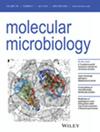Dissecting the role of the MS‐ring protein FliF in Bacillus cereus flagella‐related functions
IF 2.6
2区 生物学
Q3 BIOCHEMISTRY & MOLECULAR BIOLOGY
引用次数: 0
Abstract
The flagellar MS‐ring, uniquely constituted by FliF, is essential for flagellar biogenesis and functionality in several bacteria. The aim of this study was to dissect the role of FliF in the Gram‐positive and peritrichously flagellated剖析 MS 环蛋白 FliF 在蜡样芽孢杆菌鞭毛相关功能中的作用
在一些细菌中,由 FliF 独特构成的鞭毛 MS 环对鞭毛的生物发生和功能至关重要。本研究旨在剖析 FliF 在革兰氏阳性和具周鞭毛的蜡样芽孢杆菌中的作用。我们证明了 fliF 与上游基因 fliE 形成了一个操作子。对蜡样芽孢杆菌 ATCC 14579 FliF 的硅学分析确定了蛋白质功能所必需的功能域和氨基酸残基。本研究使用无标记基因替换法构建了蜡样芽孢杆菌的 ΔfliF 突变体,对该突变体的分析表明,与亲本菌株相比,该突变体能够组装鞭毛,但数量有所减少,这出乎意料。然而,fliF 基因缺失会导致运动能力完全丧失。FliF缺失会导致浸没生物膜的产生,并影响蜡样芽孢杆菌粘附在胃肠道粘蛋白上的能力。我们还发现,fliF 缺失不会影响溶血素 BL(一种通过鞭毛Ⅲ型分泌系统分泌的毒素)三种成分的分泌。总之,我们的研究结果凸显了蜡样芽孢杆菌 FliF 在鞭毛相关功能中的重要作用,它是完全鞭毛、运动、粘蛋白粘附和小球生物膜所需的蛋白质。
本文章由计算机程序翻译,如有差异,请以英文原文为准。
求助全文
约1分钟内获得全文
求助全文
来源期刊

Molecular Microbiology
生物-生化与分子生物学
CiteScore
7.20
自引率
5.60%
发文量
132
审稿时长
1.7 months
期刊介绍:
Molecular Microbiology, the leading primary journal in the microbial sciences, publishes molecular studies of Bacteria, Archaea, eukaryotic microorganisms, and their viruses.
Research papers should lead to a deeper understanding of the molecular principles underlying basic physiological processes or mechanisms. Appropriate topics include gene expression and regulation, pathogenicity and virulence, physiology and metabolism, synthesis of macromolecules (proteins, nucleic acids, lipids, polysaccharides, etc), cell biology and subcellular organization, membrane biogenesis and function, traffic and transport, cell-cell communication and signalling pathways, evolution and gene transfer. Articles focused on host responses (cellular or immunological) to pathogens or on microbial ecology should be directed to our sister journals Cellular Microbiology and Environmental Microbiology, respectively.
 求助内容:
求助内容: 应助结果提醒方式:
应助结果提醒方式:


